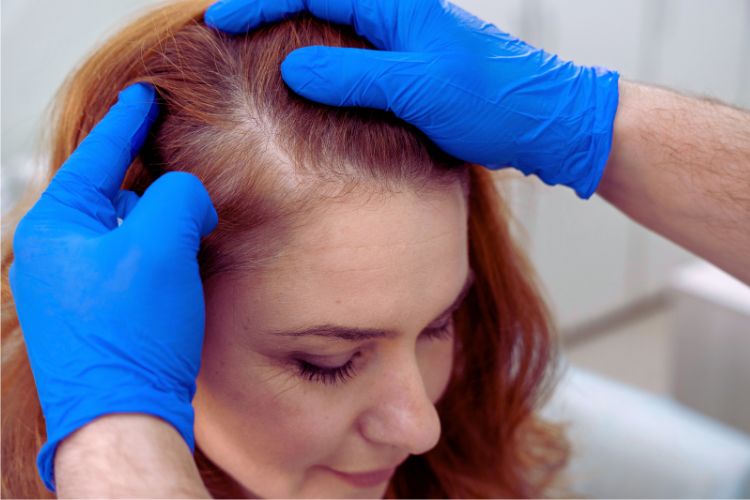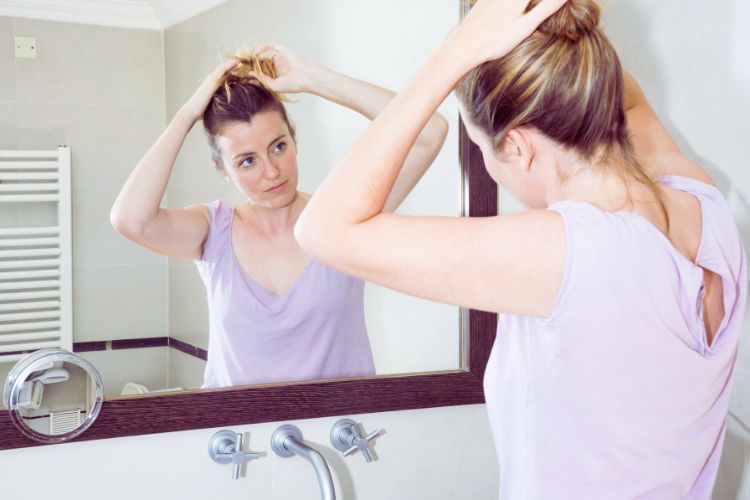Brief overview of Minoxidil as a hair loss treatment
Minoxidil is a topical medication used to treat hair loss, specifically androgenetic alopecia, which is a common form of hair loss in both men and women. It was originally developed as an oral medication to treat high blood pressure, but it was found to have the side effect of hair growth. Minoxidil works by increasing blood flow and nutrient delivery to hair follicles, which can stimulate hair growth and prolong the growth phase of hair.
Minoxidil is applied directly to the scalp twice a day, and it typically takes several months to see results. It is available over the counter in various strengths and formulations, including a 2% solution for women and a 5% solution for men. Some common side effects of minoxidil include scalp irritation, itching, and dryness.
While minoxidil is an effective hair loss treatment for some individuals, it does not work for everyone, and it may not be suitable for individuals with certain medical conditions or those taking certain medications. It is important to consult with a healthcare provider before using minoxidil or any other hair loss treatment.
Importance of understanding the potential side effects of minoxidil before starting treatment
It is crucial to understand the potential side effects of minoxidil or any medication before starting treatment, and minoxidil is no exception. While minoxidil is generally considered safe, it can cause side effects such as scalp irritation, itching, and dryness. Additionally, some individuals may experience more serious side effects of minoxidil, such as chest pain, rapid heartbeat, and swelling of the face or hands.
Understanding the potential side effects of minoxidil before starting treatment can help individuals make an informed decision about whether it is the right option for them, and can help them monitor for any adverse effects that may occur during treatment. It is important to consult with a healthcare provider before using minoxidil or any other hair loss treatment, and to report any side effects of minoxidil experienced during treatment promptly.
I. How Minoxidil Works

1. Brief explanation of Minoxidil’s mechanism of action
The exact mechanism of action of minoxidil as a hair loss treatment is not fully understood, but it is thought to work by increasing blood flow and nutrient delivery to hair follicles. Minoxidil is a vasodilator, meaning it widens blood vessels and increases blood flow. When applied topically to the scalp, it can improve the circulation of blood and nutrients to hair follicles, which can stimulate hair growth and prolong the growth phase of hair.
Minoxidil may also affect the activity of hair follicle cells, including those responsible for hair growth and hair shaft diameter. It has been shown to increase the size of hair follicles, and to increase the duration of the anagen (growth) phase of the hair cycle. Additionally, minoxidil may help to counteract the effects of dihydrotestosterone (DHT), a hormone that can contribute to hair loss in individuals with androgenetic alopecia. Overall, while the exact mechanism of action of minoxidil is not fully understood, it is thought to work by improving blood flow and nutrient delivery to hair follicles, and by affecting the activity of hair follicle cells.
2. Differences between topical and oral Minoxidil
Minoxidil is available in both topical and oral formulations, but the two differ in several important ways. Topical minoxidil is applied directly to the scalp and works locally to stimulate hair growth, while oral minoxidil is taken by mouth and circulates throughout the body.
Topical minoxidil is the preferred form of treatment for hair loss because it has fewer side effects than oral minoxidil. The topical application of minoxidil reduces the likelihood of systemic side effects of minoxidil and may limit the extent of absorption. Additionally, topical minoxidil is generally well-tolerated, and the most common side effect is scalp irritation.
Oral minoxidil, on the other hand, can cause more significant side effects of minoxidil, including low blood pressure, fluid retention, and increased heart rate. It is typically only used as a second-line treatment for severe cases of hypertension that have not responded to other medications. In the context of hair loss treatment, oral minoxidil is not commonly used, and topical minoxidil is the preferred form of treatment.
In summary, while both topical and oral minoxidil can stimulate hair growth, the topical formulation is the preferred form of treatment for hair loss because it has fewer side effects of minoxidil and is better tolerated.
II. Common Side Effects of Minoxidil as Topical Treatment

1. Skin irritation and itching
One of the most common side effects of minoxidil is skin irritation and itching, which can occur on the scalp or other areas of skin where the medication is applied. This can be due to the alcohol content of the solution or foam, which can be drying and irritating to the skin. Itching can also be a sign of an allergic reaction to minoxidil.
To minimize skin irritation and itching, it is important to apply minoxidil as directed, using only the recommended amount and frequency. It is also recommended to avoid using other hair care products on the scalp immediately after applying minoxidil, as this can further irritate the skin.
If skin irritation or itching is severe or persistent, it is important to contact a healthcare provider. They may recommend a different strength or formulation of treatment, or may suggest other treatments to alleviate the symptoms. In most cases, skin irritation and itching from mild and temporary, and will resolve with continued use of the medication.
2. Redness and dryness of the scalp
Another common side effect of this treatment is redness and dryness of the scalp. This can occur as a result of the alcohol content of the solution or foam, which can be drying and irritating to the skin. In some cases, it may also be due to an allergic reaction to minoxidil.
To minimize redness and dryness of the scalp, it is important to apply it as directed, using only the recommended amount and frequency. It may also be helpful to use a moisturizing conditioner or oil to help soothe the scalp and reduce dryness.
If redness and dryness of the scalp are severe or persistent, it is important to contact a healthcare provider. They may recommend a different strength or formulation of treatment, or may suggest other treatments to alleviate the symptoms. In most cases, redness and dryness of the scalp from minoxidil are mild and temporary, and will resolve with continued use of the medication.
3. Unwanted hair growth in nearby areas
Another potential side effect of minoxidil is unwanted hair growth in nearby areas, such as the forehead, cheeks, or neck. This can occur when the medication is accidentally applied to areas outside of the intended treatment area, or when the medication is transferred from the scalp to nearby areas through contact or hair styling.
To minimize the risk of unwanted hair growth, it is important to apply minoxidil only to the scalp, using only the recommended amount and frequency. It is also recommended to avoid applying it near the hairline or on the forehead to prevent unintentional transfer to nearby areas.
If unwanted hair growth does occur, it can usually be managed by stopping the use of minoxidil or by adjusting the application technique. In some cases, hair removal treatments such as shaving, waxing, or laser therapy may be necessary. It is important to speak with a healthcare provider if unwanted hair growth is a concern, as they may recommend other treatments or adjustments to the regimen.
4. Temporary shedding during the initial treatment phase
Another side effect of minoxidil is temporary shedding during the initial treatment phase. This occurs when the medication stimulates new hair growth and pushes older hairs into the shedding phase of the hair cycle. The shedding typically occurs within the first 2-6 weeks of treatment and can last for several weeks.
While the temporary shedding can be concerning, it is a sign that the medication is working and stimulating new hair growth. It is important to continue using this treatment as directed, even during the shedding phase, to allow new hair growth to occur. If shedding is severe or persistent, it is important to contact a healthcare provider. They may recommend adjusting the minoxidil regimen or suggest other treatments to address the shedding. In most cases, temporary shedding from minoxidil is mild and temporary, and will resolve with continued use of the medication.
III. Rare Side Effects of Minoxidil as Topical Treatment

Allergic reactions and contact dermatitis: In rare cases, users may experience severe skin reactions such as rashes, hives, or swelling.
Dizziness or lightheadedness: Some individuals may experience dizziness or lightheadedness due to systemic absorption of Minoxidil. Heart palpitations or changes in blood pressure: Although uncommon, some people may experience changes in heart rate or blood pressure.
IV. Side Effects of Minoxidil : Oral treatment

Swelling due to fluid retention: Oral Minoxidil may cause edema, or swelling, especially in the lower extremities.
Fatigue and dizziness: Users may experience dizziness or fatigue as a result of blood pressure changes.
Chest pain and heart palpitations: It may cause chest pain or an irregular heartbeat in rare cases.
Weight gain: Some individuals may experience weight gain due to fluid retention.
V. Risk Factors and Precautions

Medical conditions that may increase the risk of side effects of minoxidil: People with heart problems, kidney or liver disease, and high blood pressure should consult their healthcare provider before using this treatment.
Potential drug interactions: It may interact with certain medications, so it’s essential to discuss any current medications with your healthcare provider.
Pregnancy and breastfeeding considerations: this treatment should not be used by pregnant or breastfeeding women, as it may pose risks to the developing fetus or nursing infant.
VI. Managing Side Effects of minoxidil and What to Do If You Experience Them

1. Tips for minimizing common side effects of minoxidil
There are several tips to minimize the common side effects of minoxidil. To reduce skin irritation and itching, it is recommended to apply it only to a clean, dry scalp and avoid using other hair care products immediately after application. It is also important to use only the recommended amount and frequency of minoxidil to minimize skin irritation.
To reduce redness and dryness of the scalp, it may be helpful to use a moisturizing conditioner or oil to soothe the skin. To minimize the risk of unwanted hair growth in nearby areas, it is important to apply minoxidil only to the scalp and avoid applying it near the hairline or on the forehead.
It is also recommended to wash hands thoroughly after applying this treatment to prevent unintentional transfer to nearby areas. Finally, to minimize temporary shedding during the initial treatment phase, it is important to continue using it as directed, even during the shedding phase, and to be patient as new hair growth occurs.
2. When to consult a healthcare professional
It is important to consult a healthcare professional if any side effects of minoxidil are severe or persistent, or if there are any concerns about the medication’s use. This includes symptoms such as chest pain, rapid heartbeat, swelling of the face or hands, or difficulty breathing, which may indicate an allergic reaction or more serious side effects.
Additionally, if there is significant or persistent skin irritation, itching, redness, or dryness, or if there is unwanted hair growth in nearby areas, it is important to speak with a healthcare provider. They may recommend adjusting the minoxidil regimen, switching to a different strength or formulation, or suggest other treatments to address the side effects of minoxidil.
Overall, while minoxidil is generally considered safe and well-tolerated, it is important to monitor for side effects of minoxidil and to consult with a healthcare professional if there are any concerns. They can provide guidance on the appropriate use of the medication and suggest other treatments to address any side effects that may occur.
Conclusion
Balancing the benefits of minoxidil with potential side effects of minoxidil is an important consideration when deciding whether to use this medication for hair loss treatment. While it can effectively stimulate hair growth and prolong the growth phase of hair, it can also cause side effects such as skin irritation, itching, redness and dryness of the scalp, and unwanted hair growth in nearby areas.
When deciding whether to use this treatment, it is important to weigh the potential benefits against the risks of side effects. For many individuals, its benefits may outweigh the potential side effects of minoxidil, especially when used as directed and monitored by a healthcare professional.
It is important to also consider alternative hair loss treatments and discuss them with a healthcare professional. Additionally, lifestyle changes such as a healthy diet, exercise, and stress management can also help to support hair health and minimize hair loss.
Overall, balancing its benefits with potential side effects of minoxidil is a personal decision that should be made in consultation with a healthcare professional. By understanding the potential risks and taking appropriate precautions, individuals can effectively manage hair loss while minimizing the risk of adverse effects.
At Naturiam, we propose a natural solid shampoo infused with ginseng and a growth oil made with proved natural ingredients for hair growth such as pumpkin oil, rosemary cineol oil, Hinoki oil and much more.




